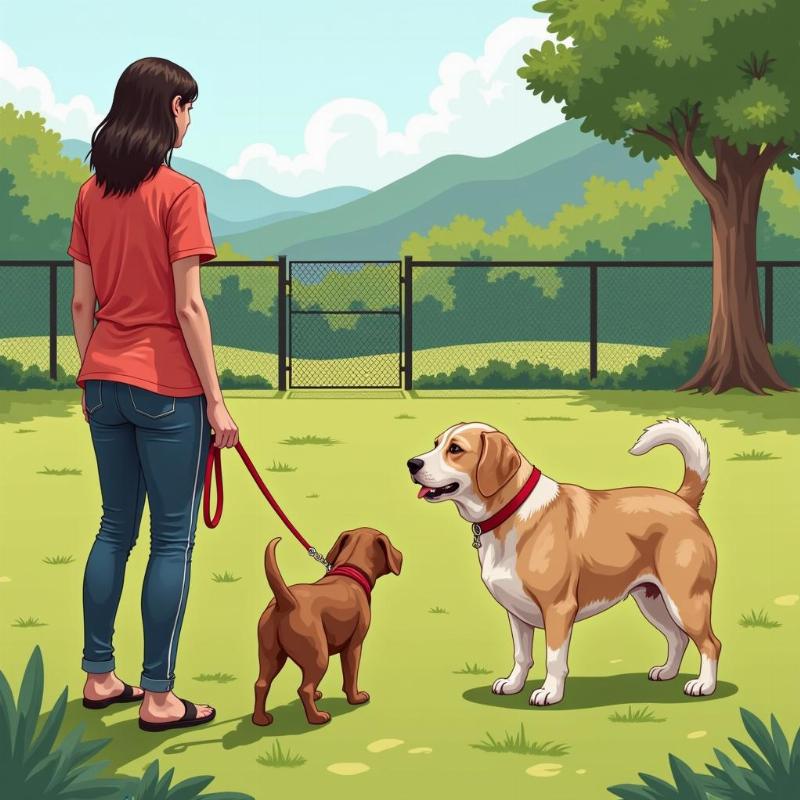When a big dog bites a small dog, the consequences can be devastating. The size difference alone makes small dogs incredibly vulnerable. This article provides practical advice and crucial information for owners of both large and small breeds to understand the dynamics behind these incidents and, most importantly, how to prevent them. We’ll explore everything from recognizing canine body language to creating safe spaces for all dogs.
Understanding the Dynamics: Why Big Dogs Might Bite Small Dogs
Several factors can contribute to aggression between dogs of different sizes. Predatory drift, a natural instinct where larger dogs may perceive smaller, fast-moving animals as prey, is a key concern. Fear and territoriality also play significant roles. A large dog may feel threatened by a small dog’s assertive behavior, while a small dog might display fear-based aggression, leading to escalation. Miscommunication between dogs due to differing body language signals can also spark conflict.
It’s vital to remember that any dog, regardless of size, can bite. Understanding these underlying causes is the first step in preventing unfortunate incidents.
Preventing Big Dog Bites on Small Dogs: Proactive Measures
Prevention is paramount. Socialization from an early age is crucial for both large and small breeds. Expose your dog to a variety of dogs, sizes, and environments to help them develop appropriate social skills. Obedience training, especially focusing on commands like “leave it” and “come,” is essential for maintaining control in potentially tense situations.
Always supervise interactions between large and small dogs, especially during initial introductions. Use leashes to manage the interaction and prevent sudden movements. Create separate spaces within your home or yard where each dog can retreat and feel safe. This is especially important if one dog is showing signs of stress or discomfort. Provide plenty of resources like toys, food, and water bowls to minimize competition and potential conflict.
 Dog Park Safety Tips for Big and Small Dogs
Dog Park Safety Tips for Big and Small Dogs
Recognizing Warning Signs: Canine Body Language
Learning to interpret canine body language is crucial for preventing bites. A stiff body, direct stare, raised hackles, lip curling, and a low growl are all warning signs that a dog is feeling uncomfortable or threatened. If you observe these signs in either the large or small dog, immediately separate them.
What to Do if a Big Dog Bites a Small Dog: Immediate Action
If a bite occurs, prioritize the safety of both dogs. Separate them immediately and calmly. Check the small dog for injuries and seek veterinary attention as needed. Even seemingly minor bites can lead to infections or other complications. Exchange contact information with the other owner. Document the incident thoroughly, including the date, time, location, and a description of what happened. This information can be crucial for future prevention and for any potential legal or insurance matters.
Creating a Safe and Harmonious Multi-Dog Household
Living with dogs of different sizes can be a rewarding experience, but it requires careful management and understanding. By prioritizing prevention, recognizing warning signs, and taking appropriate action, you can create a safe and harmonious environment for all your canine companions.
FAQ
- How can I introduce my large dog to a new small dog safely? Introduce them gradually in a neutral, controlled environment using leashes and close supervision.
- Is it ever safe to leave a large and small dog unsupervised? It’s generally not recommended, especially if there’s a history of tension or aggression.
- What are the most common signs of fear or aggression in dogs? Common signs include lip curling, growling, tucked tail, whale eye (showing the whites of the eyes), and a stiff body posture.
- My small dog is very assertive. Could this provoke a larger dog? Yes, small dog assertiveness can be perceived as a threat by larger dogs.
- What should I do if my large dog shows predatory behavior towards my small dog? Consult a certified professional dog trainer or veterinary behaviorist for guidance.
- Are certain breeds more prone to biting? While any dog can bite, some breeds have stronger prey drives than others.
- How can I find a qualified dog trainer or behaviorist? The American Kennel Club (AKC) and the Certification Council for Professional Dog Trainers (CCPDT) are excellent resources.
Related Articles on Beautdogs.us
(No related articles found at this time.)
About Beautdogs.us
Beautdogs.us is your premier online destination for all things dog-related in the US. We provide expert advice on dog breeds, care, training, and the latest products and services. Whether you’re a first-time dog owner or a seasoned pro, Beautdogs.us is your trusted resource for comprehensive and engaging information. We help you navigate the joys and challenges of dog ownership with confidence and provide tailored guidance for a happy, healthy dog. For inquiries, contact us at [email protected] or call us at +1 501-555-7529.